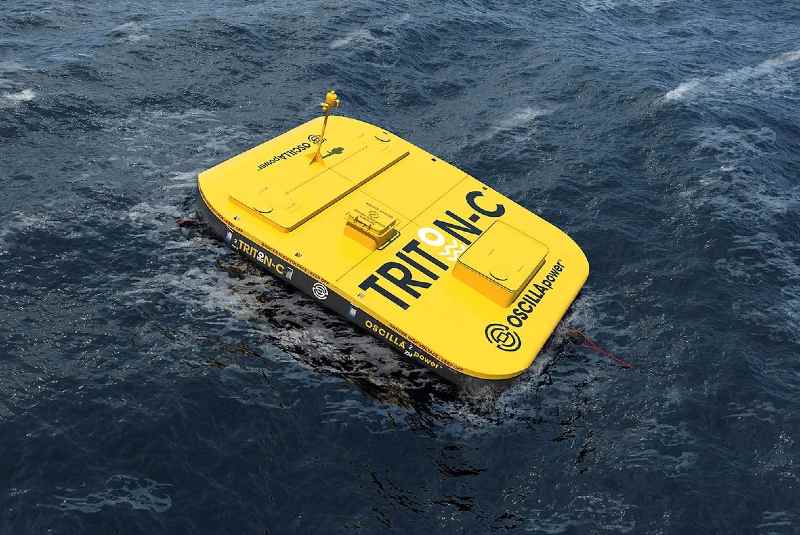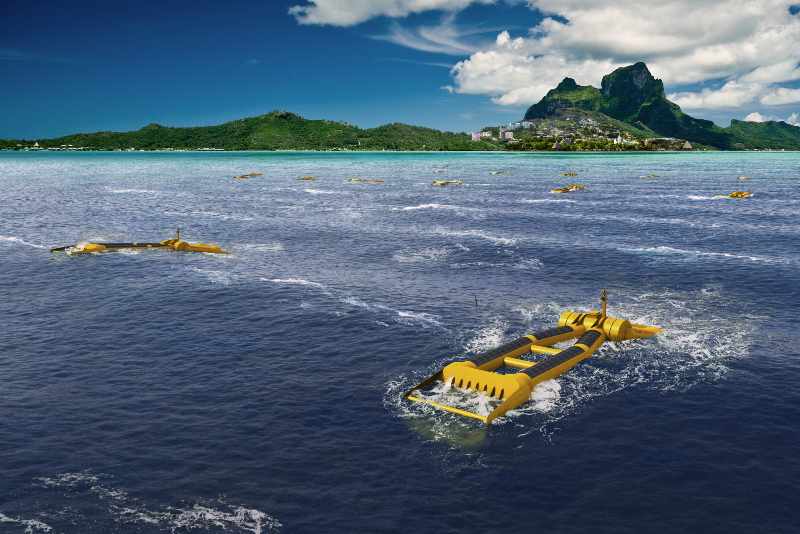
Marine energy technologies are certainly not new to the clean energy scene. Technologies that use kinetic force from the waves or tap into tides and currents to generate electricity are however gaining ground and in some instances gaining significant financial support to expedite commercialisation.
Here’s a selection of five that caught our attention, the attention of investors… and caught a few waves too.
Oscilla Power

Seattle-based Oscilla Power is producing two wave energy systems with a multi-mode architecture: the Triton and the Triton-C. The Triton is a 1MW rated power system that is designed to be installed in large arrays to provide utility-scale power while the Triton-C is a 100kW system designed for isolated power-at-sea applications or remote communities.
Triton’s three-tendon architecture enables energy capture from the ocean in all six degrees of freedom (heave, pitch, surge, roll, and yaw) enabling power to be produced across a very wide range of wave conditions. The optimised surface float geometry and ring-shaped reaction structure work together to amplify this effect and increase generated power.
The company recently completed preliminary steps towards commercialising its Triton-C technology; relocating the system and performing setup and staging activities at the launch site at the Wave Energy Test Site in Hawaii. This will eventually lead to the full-scale demonstration by the US Navy.
Orbital Marine Power

UK tidal company, Orbital Marine Power, is responsible for the O2 tidal turbine which has been operational since July 2021 in Orkney, where it is connected to the UK electricity grid. It is a 74m long floating superstructure, supporting two 1MW turbines on either side for a nameplate power output of 2MW.
It can generate enough clean electricity to meet the demand of around 2,000 homes and offset approximately 2,200 tonnes of CO2 production per year. It works with twin turbines fixed to retractable legs. The legs are mounted to a floating platform enabling the tidal turbine to be positioned in the most energetic parts of the water flow.
According to Orbital, platform and blade configurations cater for sites of differing characteristics and scale, and turbines can be deployed in arrays much like wind turbines. Orbital Marine was recently awarded two Contracts for Difference (CfDs) for 7.2MW in the UK Allocation Round 5 process. The CfDs will allow Orbital to expand its development of projects in Orkney with the construction of six turbines now covered by the Contracts for Difference scheme.
Listen to the Energy Transition podcast:
Marine energy – From bathtub to the big blue
AW-Energy Oy

Finnish wave tech specialists are responsible for developing the WaveRoller. Waveroller-C and WaveRoller-D are utility-scale devices that convert ocean wave energy to electricity.
The devices operate in near-shore areas (approximately 0.3-2 km from the shore) at depths of between 8 and 20 meters. Depending on tidal conditions the units can be partly or fully submerged and anchored to the seabed.
A single WaveRoller-C unit is rated between 125kW and 400kW. WaveRoller-D is a larger device rated between 500kW and 1,200kW. The capacity factor of the devices is 25-50% depending on wave conditions at the project site. The technology can be deployed as single units or in farms.
The latest project aimed to commercialise the technology is the WaveFarm project funded by the European Maritime and Fisheries Fund. This project will result in a total of 273,626 T of CO2 reduction by 2027.
Have you read?
CorPower delivers composite hull for wave energy converter
Is wave energy the key to a balanced electricity system?
Mocean Energy

UK-based wave energy tech firm Mocean Energy has developed two wave energy technologies: the Blue Star, a device to power a range of subsea equipment, inspection and maintenance systems; and the Blue Horizon, a utility-scale machine, designed for deployment in wave farms off the coast to deliver green energy to transmission networks where needed.
Both technologies are based on the same concept — a hinged raft with a unique geometry that improves performance and increases survivability by diving through the largest waves.
The team has received support from Wave Energy Scotland to develop the Blue X — a prototype model for extensive testing in real sea conditions. In 2021, Mocean shipped the Blue X to the European Marine Energy Centre in Orkney to commence testing. The Blue X is now generating power as well as data on machine performance and operation.
Minesto

Minesto’s technology generates electricity from tidal streams and ocean currents by using a unique, patented kite technology. The wing uses the hydrodynamic lift force created by the underwater current to move the kite.
With an onboard control system, the kite is autonomously steered in a predetermined figure-of-eight trajectory, pulling the turbine through the water at a water flow several times higher than the actual stream speed. The turbine shaft turns the generator which outputs electricity to the grid via a power cable in the tether and a seabed umbilical to the shore.
First electricity was generated in 2019 and in April 2022, Minesto announced a detailed plan for large-scale buildout of tidal energy arrays in the Faroe Islands. The large-scale buildout plan sets out a stepwise installation of tidal kite arrays at four locations. With a total capacity of 120MW tidal energy, generating an estimated 350GWh per year, the arrays would supply 40% of the Faroe Islands’ electricity consumption.




